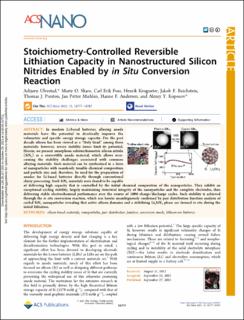| dc.contributor.author | Ulvestad, Asbjørn | |
| dc.contributor.author | Skare, Marte Orderud | |
| dc.contributor.author | Foss, Carl Erik Lie | |
| dc.contributor.author | Krogsæter, Henrik | |
| dc.contributor.author | Reichstein, Jakob | |
| dc.contributor.author | Preston, Thomas J. | |
| dc.contributor.author | Mæhlen, Jan Petter | |
| dc.contributor.author | Andersen, Hanne Flåten | |
| dc.contributor.author | Koposov, Alexey | |
| dc.date.accessioned | 2021-11-03T13:07:46Z | |
| dc.date.available | 2021-11-03T13:07:46Z | |
| dc.date.created | 2021-10-06T09:32:48Z | |
| dc.date.issued | 2021 | |
| dc.identifier.citation | ACS Nano. 2021, 15 (10), 16777-16787. | en_US |
| dc.identifier.issn | 1936-0851 | |
| dc.identifier.uri | https://hdl.handle.net/11250/2827638 | |
| dc.description.abstract | In modern Li-based batteries, alloying anode materials have the potential to drastically improve the volumetric and specific energy storage capacity. For the past decade silicon has been viewed as a “Holy Grail” among these materials; however, severe stability issues limit its potential. Herein, we present amorphous substoichiometric silicon nitride (SiNx) as a convertible anode material, which allows overcoming the stability challenges associated with common alloying materials. Such material can be synthesized in a form of nanoparticles with seamlessly tunable chemical composition and particle size and, therefore, be used for the preparation of anodes for Li-based batteries directly through conventional slurry processing. Such SiNx materials were found to be capable of delivering high capacity that is controlled by the initial chemical composition of the nanoparticles. They exhibit an exceptional cycling stability, largely maintaining structural integrity of the nanoparticles and the complete electrodes, thus delivering stable electrochemical performance over the course of 1000 charge/discharge cycles. Such stability is achieved through the in situ conversion reaction, which was herein unambiguously confirmed by pair distribution function analysis of cycled SiNx nanoparticles revealing that active silicon domains and a stabilizing Li2SiN2 phase are formed in situ during the initial lithiation. | en_US |
| dc.language.iso | eng | en_US |
| dc.publisher | American Chemical Society | en_US |
| dc.rights | Navngivelse 4.0 Internasjonal | * |
| dc.rights.uri | http://creativecommons.org/licenses/by/4.0/deed.no | * |
| dc.title | Stoichiometry-Controlled Reversible Lithiation Capacity in Nanostructured Silicon Nitrides Enabled by in Situ Conversion Reaction | en_US |
| dc.type | Peer reviewed | en_US |
| dc.type | Journal article | en_US |
| dc.description.version | publishedVersion | en_US |
| dc.source.pagenumber | 16777-16787 | en_US |
| dc.source.volume | 15 | en_US |
| dc.source.journal | ACS Nano | en_US |
| dc.source.issue | 10 | en_US |
| dc.identifier.doi | 10.1021/acsnano.1c06927 | |
| dc.identifier.cristin | 1943652 | |
| dc.relation.project | Norges forskningsråd: 257653 | en_US |
| dc.relation.project | Norges forskningsråd: 280885 | en_US |
| dc.relation.project | Norges forskningsråd: 280985 | en_US |
| cristin.ispublished | true | |
| cristin.fulltext | original | |
| cristin.qualitycode | 1 | |

